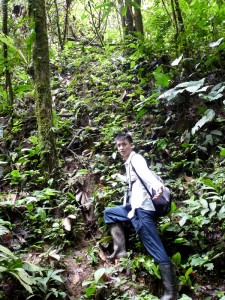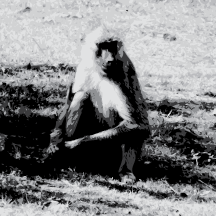Being located about two hours downriver from the nearest human settlement, all food, supplies, and visitors arrive at Tiputini by boat, which run only on Mondays and Fridays. This is actually very important to know if, like me, you micromanage your stash of Oreos and juice boxes. Also, these days can be exciting when they bring in new faces (I feel like an aquarium fish). Laundry is done for us twice a week, on Tuesdays and Saturdays. Boat rides and laundry days are how I keep track of days. Tomorrow is Laundry Day (oh boy!).
The water here is pumped directly from the Tiputini River, then passed through a water tower where it is filtered, chlorinated, and distributed to all the buildings of the station. Since all of the running water passes through this system, that means you use the same water to drink, to shower, and to flush. Since the system can only handle so much, water use is self-regulated. Nevertheless, when the station is crowded, we are almost certain to run out of water.
The station does have electricity, but cabins are powered only during hours when the generator is running, from 10am to 1pm and again from 6pm to 9:30pm. After it gets dark (around 6pm), flashlights or headlamps are indispensible for moving about the station, especially when there is no electricity. Lights and outlets in the central research building (office, library, and lab) are powered 24/7, although large appliances such as the air conditioning run with the generator. Expensive electronics are stored in “dry boxes,” large wooden boxes containing an incandescent light bulb and sometimes a desiccant such as silica. There is a satellite internet connection, which can be quite slow but is nonetheless a huge luxury in a place like this.
The food here is pretty good and the station staff (the Tigres) do a great job with the limited supplies that they have. I picked up where I left off, however, and have been avoiding peanut butter and jelly sandwiches, served on the ubiquitous dinner rolls that find their way into almost every meal. Those sandwiches are the standard items to take into the field; they can get moldy, however, in the field. Luckily, you can request “comida,” which is usually leftovers from the previous day and far superior to PBJ sandwiches. Breakfast can be anything from pancakes to French toast (made from dinner rolls) to scrambled eggs. Cereal is available every morning and tea and coffee are available throughout the day. Dinners (sometimes the only meal I eat in the station) are quite good and go far beyond the typical “rice and beans” that most field researchers eat in the Neotropics. So far, we’ve had chickpeas and rice, chicken with corn and mashed potatoes, and lasagna. Yum.
While hiking along the Puma plot (one of two 1km x 1km plots at the station) this morning, I came across the next in my series of “Things I don’t miss (but had forgotten about).”
Things I don’t miss (but had forgotten about): Gorges
Actually, these can be quite fun, but my initial thought when coming across these steep cliffs is something like, “Oh hell no.” Moving up or, in particular, down gorges involves a few seconds of planning. Should I run it? Should I jump it? Or should I do a controlled tumble? The issue is that there are often few footholds and many are prone to crumbling. Sometimes, there are trees to grab on to, but doing so runs the risk of annoying a conga ant, the “most painful” insect of the order Hymenoptera (biological group including ants, bees, wasps, and grizzly bears). In reality, gorges are much easier to maneuver across than they look, but I still find them scary as hell, especially when I am rushing so as not to fall behind my monkeys. At times like these, I miss parasitizing off of the routes of the much more surefooted Ricardo or Chris. Tony, on the other hand, crumbles all existing footholds, making it much more difficult for the next person (in his defense, he will offer a hand).

What do I do with this?


 RSS
RSS
Do you eat your lunch in the middle of the rainforest? Does this attract other animals?
Those gorges look dangerous! Maybe you can carry some sort of compact lunch tray that you can use to slide down the gorge. It would be a bumpy ride, but maybe not so bad.
Lisa: We do indeed eat our lunches in the middle of the forest. I usually bring comida in a tupperware and eat it standing. When there are monkeys around, I wait to eat until the monkeys are eating or taking a nap, but sometimes they move off quickly and I have to rush to pack up and follow. The lunches don’t attract any big animals. I think their natural fear of humans would easily surpass any benefit they would get from our food. But the food that I drop certainly attracts insects, especially ants. And gorges are much easier to move up and down with your hands free, so no lunch trays :).